Blaupunkt Europe SANANTO640 Car DVD PLAYER User Manual Manual
Blaupunkt Europe GmbH Car DVD PLAYER Manual
Manual
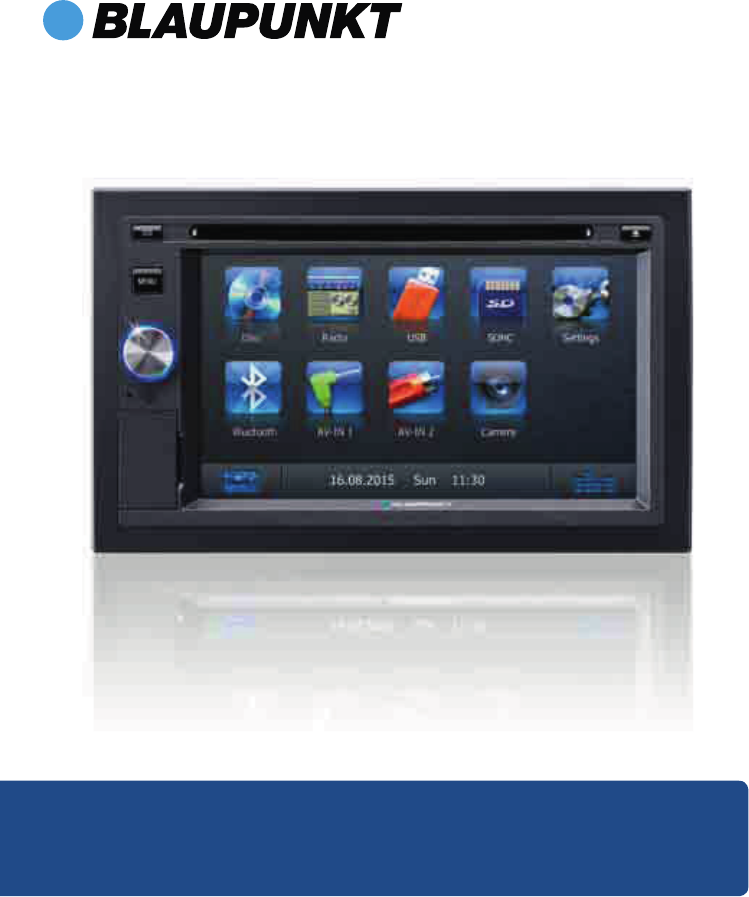
Enjoy it.
CAR MULTIMEDIA
SERIES 640
Operating instructions
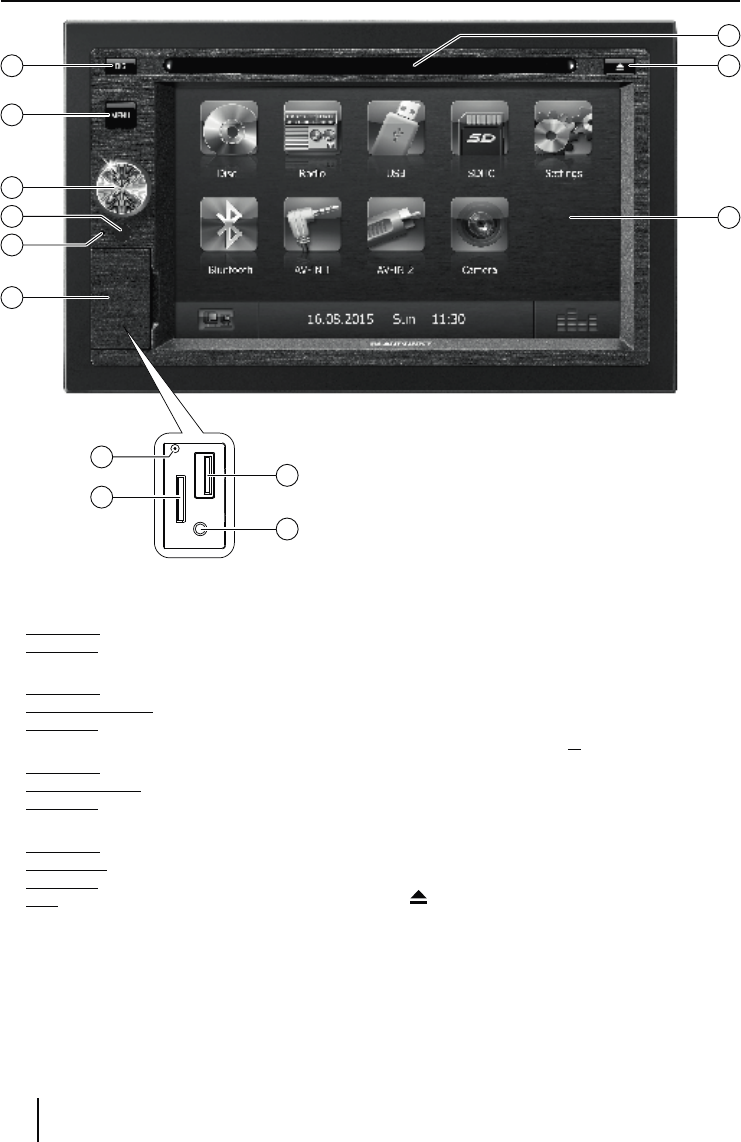
2
Controls – Device
1
DIS button
Short press: Adjust the display brightness
Long press: Switch o the display
With inserted microSD card with navigation data:
Short press: Start the navigation
In navigation mode: Call up menu of active source
Long press: Switch o the display
2
MENU button
Short press: Call up main menu
In the main menu: Call up menu of active source
Long press: Call up Bluetooth® function directly
3
Rotary/pushbutton
Short press: Switch on device
In operation: Mute audio source
Long press: Switch o device
Turn: Adjust volume
4
Infrared receiver for remote control
5
Microphone
6
Cover
7
Reset button
Access only with open cover
Restoring the original factory settings of the device.
Caution! All personal settings will be lost!
8
microSD card reader
Access only with open cover
The card reader supports microSD cards on which
either audio/video les or navigation data can be
stored.
9
Front AV-IN socket (source AV-IN 1)
Access only with open cover
:
USB socket
Access only with open cover
;
Touchscreen user interface
<
button (Eject)
Eject a DVD/CD
=
DVD/CD drive
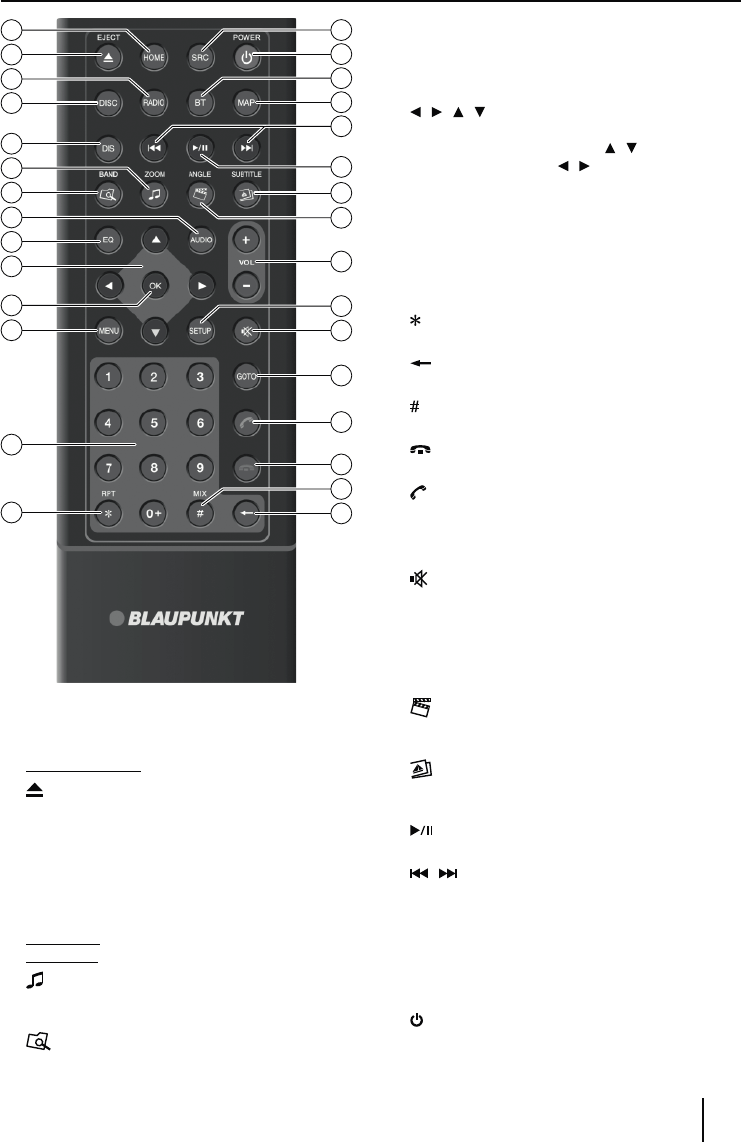
3
Controls – Remote control
?
HOME button
Call up main menu
In the main menu: Call up menu of active source
@
/ EJECT button
Eject a DVD/CD
A
RADIO button
Start radio mode
B
DISC button
Starting DVD/CD mode
C
DIS button
Short press: Adjust the display brightness
Long press: Switch o the display
D
/ ZOOM button
Call up overview of audio les
Zoom in on image area
E
/ BAND button
Call up folder overview
Select waveband/memory bank
F
AUDIO button
Select playback language (if available on DVD)
G
EQ button
Call up equaliser menu
H
/ / / button
Navigate in menus/lists
Tuning into stations manually ( / )
Calling stored stations ( / )
I
OK button
Conrm selection
J
MENU button
Call up DVD menu
Display the folder/le list
K
Number buttons 0 - 9
L
/ RPT button
Repeat function
M
button
Delete last character of an entry
N
/ MIX button
Random track play
O
button
Ending/rejecting a phone call
P
button
Answer a call
Q
GOTO button
Directly select title, chapter, movie or playtime
R
button
Mute audio source
S
SETUP button
Call up settings menu
T
VOL + / – button
Adjusting the volume
U
/ ANGLE button
Call up overview of movies
Select camera viewing angle (if available on DVD)
V
/ SUBTITLE button
Call up overview of images
Select subtitle language (if available on DVD)
W
button
Start and interrupt playback
X
/ button
Select title, chapter, movie
Fast searching
Y
MAP button
Starting the navigation
Z
BT button
Starting Bluetooth mode
[
/ POWER button
Switching device on/o
\
SRC button
Select source

4
Contents
Safety notes ................................................................ 5
Symbols used ...........................................................................5
Road safety ................................................................................5
General safety notes ..............................................................5
Declaration of conformity ....................................................5
Cleaning notes ............................................................ 5
Disposal notes............................................................. 5
Scope of delivery ........................................................ 6
Placing the device in operation ................................. 6
Switching on/o ......................................................................6
Volume ........................................................................................6
Main menu ................................................................................6
Setting the reception area ...................................................6
Radio mode ................................................................. 7
Start radio mode .....................................................................7
Select memory bank ..............................................................7
Tuning into a station ..............................................................7
Storing stations manually ....................................................7
Storing stations automatically (Travelstore) .................7
Scanning stations....................................................................7
Switching RDS on/o ............................................................7
Switching the REG function (regional
programmes) on/o ..............................................................8
Switching the AF (alternative frequencies)
function on/o .........................................................................8
Adjusting the seek tuning sensitivity ..............................8
Selecting the programme type and starting
seek tuning ................................................................................8
Switching priority for trac announcements
on/o ...........................................................................................8
Navigation (only for devices with navigation) ......... 8
Loading navigation data ......................................................8
Download of map data .........................................................8
Starting the navigation .........................................................9
Initial startup ............................................................................9
Entering a destination ...........................................................9
Address ......................................................................................9
Points of Interest ................................................................. 10
Setting route options ......................................................... 11
Map Settings .......................................................................... 11
DVD/CD/USB/microSDHC/iPod media playback .... 12
Basic information ................................................................. 12
DVD/CD mode ...................................................................... 12
USB data carrier .................................................................... 13
microSDHC cards ................................................................. 13
iPod/iPhone via USB ........................................................... 13
DVD movie playback .......................................................... 13
Audio playback from DVD/CD, USB, microSDHC
or iPod/iPhone ...................................................................... 14
Video playback from DVD/CD, USB or microSDHC ... 15
Image playback from DVD/CD, USB or audioSDHC .. 16
Bluetooth mode ........................................................ 16
Starting Bluetooth mode .................................................. 16
Registering Bluetooth devices ........................................ 16
Telephone mode .................................................................. 17
Audio playback via Bluetooth streaming .................... 17
Audio playback via app control (Android
cell phone) .............................................................................. 17
Bluetooth settings ............................................................... 18
Pandora® mode (available only in the US,
Australia and New Zealand) ..................................... 18
Requirements ....................................................................... 18
Connecting the iPod/iPhone device ............................ 18
Connecting the Android device .................................... 19
Starting the Pandora® mode ............................................ 19
Station list menu .................................................................. 19
Pandora® Error Messages .................................................. 19
External audio/video sources .................................. 20
AV inputs ................................................................................. 20
Video input ............................................................................. 20
External monitor....................................................... 20
Sound settings .......................................................... 20
Volume distribution (fader/balance) ............................ 20
Equalizer .................................................................................. 20
Basic settings ............................................................ 21
General .................................................................................... 21
Video ......................................................................................... 21
Sound ....................................................................................... 21
Time .......................................................................................... 21
Language ................................................................................ 21
Bluetooth ................................................................................ 22
Volume ..................................................................................... 22
Useful information ................................................... 22
Warranty .................................................................................. 22
Service ...................................................................................... 22
Connection diagram ................................................ 23
Appendix ................................................................... 24
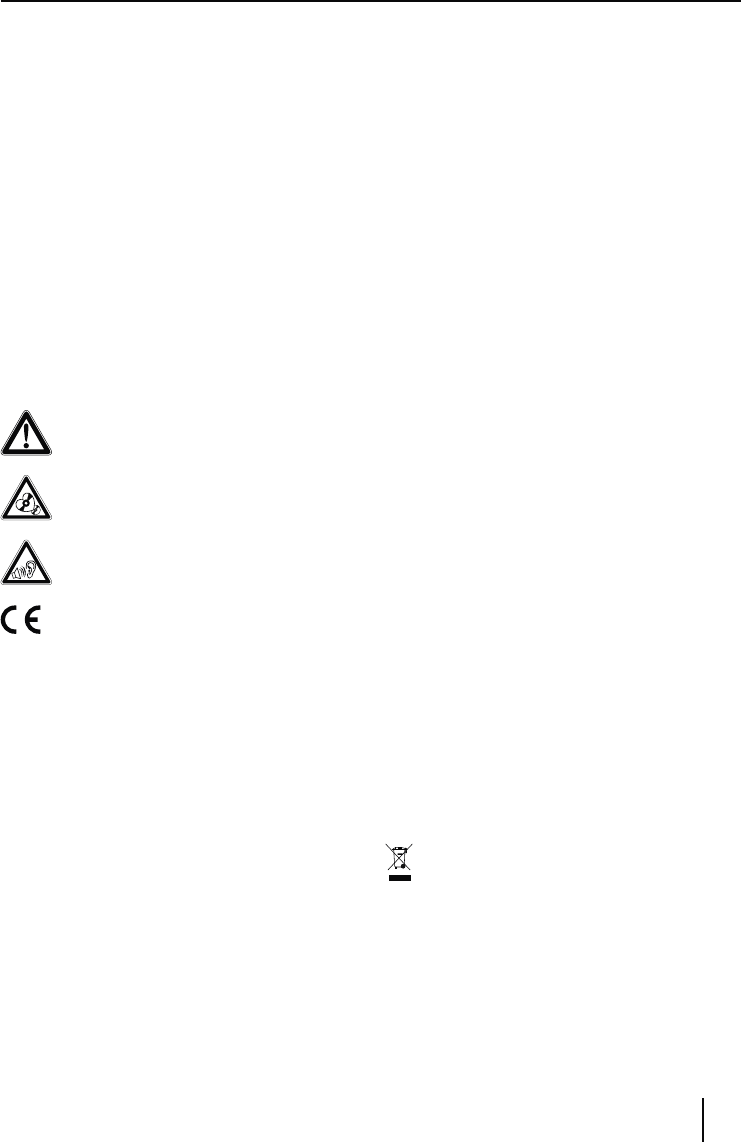
5
Safety notes | Cleaning notes | Disposal notes
Safety notes
The car sound system was manufactured according to
the state of the art and established safety guidelines.
Even so, dangers may occur if you do not observe the
safety notes in these instructions.
These instructions are intended to familiarise you with
the most important functions. Detailed information can
be found on the Internet under www.blaupunkt.com.
tRead these instructions carefully and completely
before using the car sound system.
tKeep the instructions at a location so that they
are always accessible to all users.
tAlways pass on the car sound system to third parties
together with these instructions.
In addition, observe the instructions of the devices used
in conjunction with this car sound system.
Symbols used
These instructions employ the following symbols:
DANGER!
Warns about injuries
CAUTION!
Warns about damages to the DVD/CD drive
DANGER!
Warns about high volume
The CE mark conrms the compliance with EU
directives.
uIdenties a sequencing step
tIdenties a listing
Road safety
Observe the following notes about road safety:
tUse your device in such a way that you can always
safely control your vehicle. In case of doubt, stop
at a suitable location and operate your device while
the vehicle is standing. As the driver, you may not use
the applications that will distract you from trac (de-
pending on the scope of functions of the device, e.g.
viewing videos, entering a destination).
tFollow the driving recommendations during the
route guidance only if you are not violating any
trac regulations! Trac signs and trac regula-
tions have always priority over driving recommenda-
tions.
tAlways listen at a moderate volume to protect
your hearing and to be able to hear acoustic warn-
ing signals (e.g. police sirens). During mute phases
(e.g. when changing the audio source), changing the
volume is not audible. Do not increase the volume
during this mute phase.
General safety notes
Observe the following note to protect yourself against
injuries:
Do not modify or open the device. The device contains
a Class 1 laser that can cause injuries to your eyes.
Use as directed
This car sound system is intended for installation and
operation in a vehicle with 12 V vehicle system voltage
and must be installed in a DIN slot. Observe the output
limits of the device. Repairs and installation, if necessary,
should be performed by a specialist.
Installation instructions
You may only install the car sound system yourself if you
are experienced in installing car sound systems and are
very familiar with the electrical system of the vehicle. For
this purpose, observe the connection diagram at the end
of these instructions.
Declaration of conformity
The Blaupunkt Technology GmbH declares that the de-
vice complies with the basic requirements and the other
relevant regulations of the directive 1999/5/EC.
The declaration of conformity can be found on the Inter-
net under www.blaupunkt.com.
Cleaning notes
Solvents, cleaning and scouring agents as well as dash-
board spray and plastics care product may contain in-
gredients that will damage the surface of the car sound
system.
Use only a dry or slightly moistened cloth for cleaning the
car sound system.
Disposal notes
Do not dispose of your old unit in the household
trash!
Use the return and collection systems available to
dispose of the old device, the remote control and
exhausted batteries.
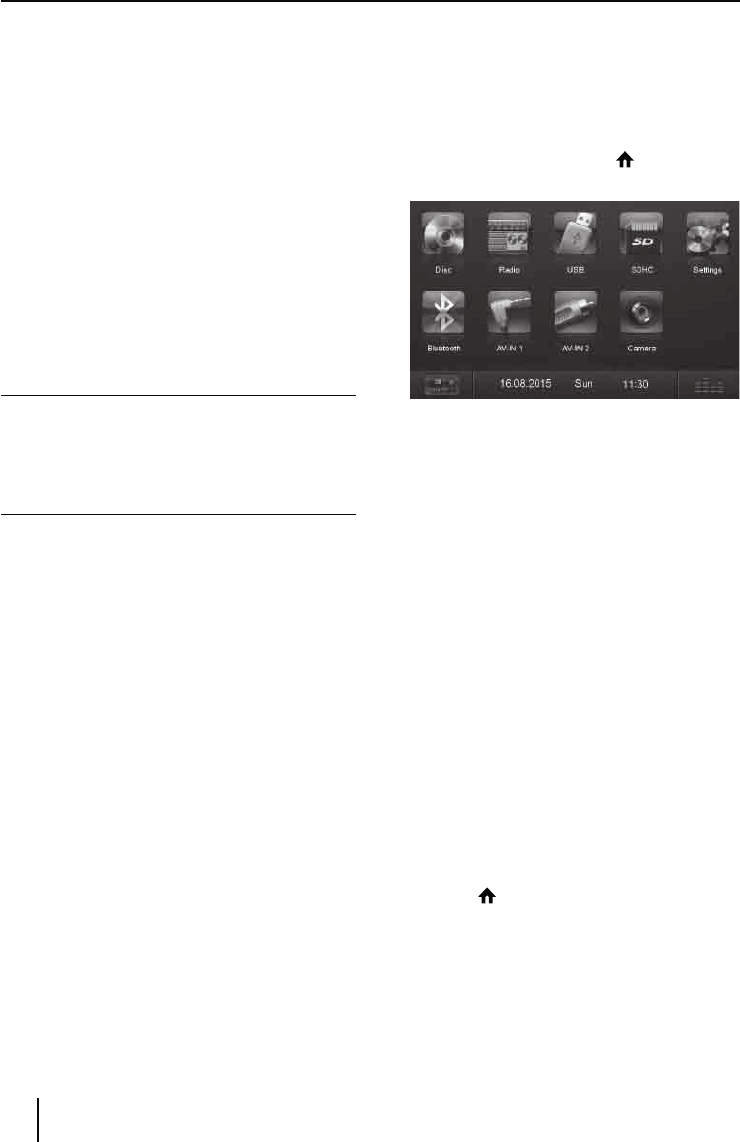
6
Scope of delivery
The scope of delivery includes:
tCar sound system
tRemote control (incl. battery)
tTMC tuner (only for devices with Europe navigation)
tmicroSD card with navigation data in the microSD
card slot (only for devices with navigation)
tGPS antenna
tExternal Bluetooth microphone
tGetting started
tSupport frame
tSmall parts set
tInstallation material
tConnecting cable
Placing the device in operation
Caution!
Transport securing screws
Ensure that the transport securing screws at the top side
of the device are removed before the startup of the de-
vice.
Switching on/o
Switching on/o with the rotary/pushbutton
uFor switch-on, press the rotary/pushbutton
3
.
uFor switch-o, hold the rotary/pushbutton
3
pressed for more than 2 seconds.
Switching on/o via vehicle ignition
If the car sound system is connected with the vehicle
ignition and it was switched o with the rotary/pushbut-
ton
3
, it is switched on or o with the ignition.
Volume
Adjusting the volume
You can adjust the volume in steps from 0 (o) to 50
(maximum).
uTurn the rotary/pushbutton
3
to change the vol-
ume.
Muting the car sound system (Mute)
uBriey press the rotary/pushbutton
3
to mute the
device or to reactivate the previous volume.
Main menu
In the main menu, you press the buttons on the touch-
screen to call up the dierent sources and operating
modes.
uPress the MENU button
2
.
- Or -
uIn the current source, press the button.
The main menu is displayed.
As long as you do not select a new audio source, the
last active audio source is played back.
Note:
The gures used in these instructions are intended
to facilitate the explanations and details may deviate
from your device.
Setting the reception area
This car sound system is designed for operation in dier-
ent regions with dierent frequency ranges and station
technologies. The factory default of the reception area is
"Europe (FM/AM)". If you operate the car sound system
outside of Europe, e.g. in the US or Asia, you may rst
have to set a suitable reception area in the menu:
uIn the main menu, press the Settings button.
The Settings menu is displayed.
uIn the bottom area of the Settings menu, press the
General button.
The current setting is displayed behind "Radio region".
uTap twice (double-click) on the Radio region but-
ton to display the list of available reception areas.
uSelect the desired reception area by double-clicking.
The list is hidden, the selected reception area is set.
uPress the button.
The main menu is displayed again.
Scope of delivery | Startup
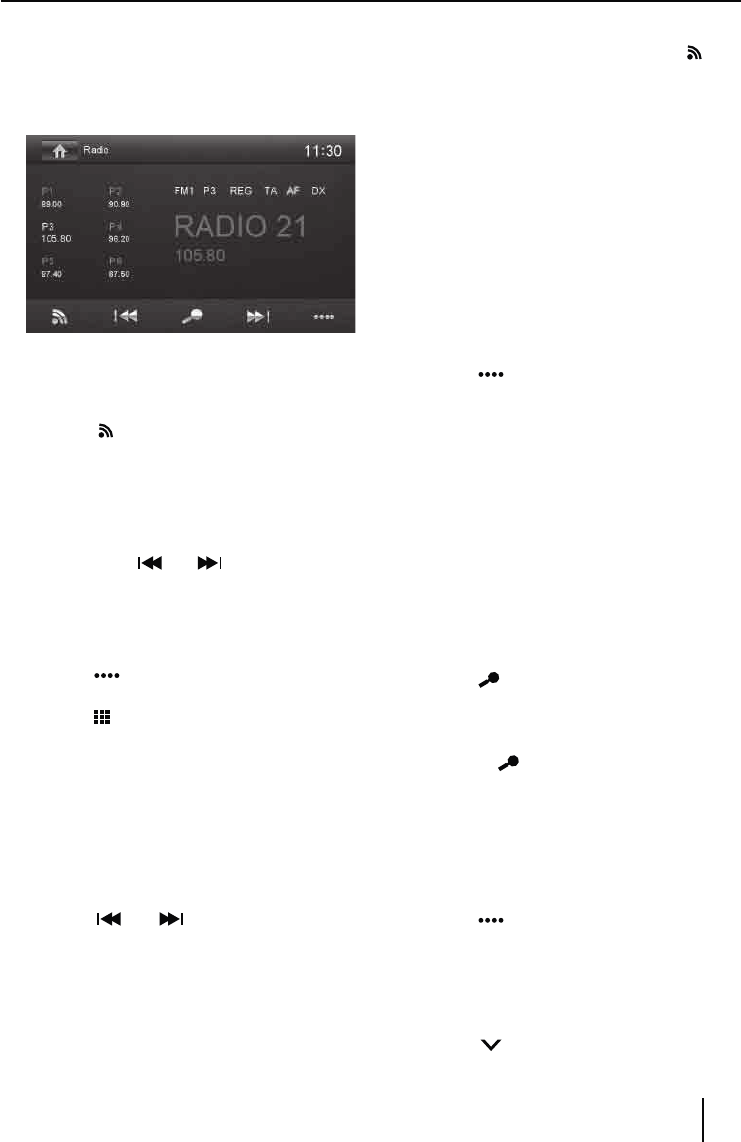
7
Radio mode
Start radio mode
uIn the main menu, press the Radio button.
The radio playback menu is displayed.
Select memory bank
Dierent memory banks and wavebands are available.
Up to 6 stations can be stored in each memory bank.
uPress the button repeatedly until the desired
memory bank is displayed.
FM1 Ǟ FM2 Ǟ FM3 Ǟ AM1 Ǟ AM2 Ǟ FM1
Tuning into a station
Tuning into stations manually
uBriey press the or button once or sev-
eral times to change the frequency in increments.
Enter broadcast frequency directly
If the frequency of the desired stations is known, it can
be entered directly via the touchscreen.
uPress the button to display additional operat-
ing options.
uPress the button.
A numeric keypad is displayed for the frequency
input.
uEnter the frequency of the desired station with the
numeric keypad.
uPress the OK button.
The radio playback menu is displayed, the station of
the frequency entered is played back.
Starting station seek tuning
uPress the or button for approx. 2 sec-
onds to start station seek tuning.
The radio tunes into the next receivable station.
Note:
For the reception area Europe: In the FM waveband,
only trac information stations are tuned into if the
priority for trac information is switched on.
Storing stations manually
uSelect the desired memory bank with the but-
ton.
uSet the desired station.
uPress one of the memory buttons P1 - P6 for
approx. 2 seconds to store the current station at the
button.
The station is stored.
Storing stations automatically
(Travelstore)
With Travelstore, you can automatically search for and
store the 6 FM stations oering the strongest reception
in the region in the current memory bank. Any previously
stored stations in this memory bank are deleted in the
process.
uSelect a memory bank.
uPress the button to display additional operat-
ing options.
uPress the TS button.
The tuner starts the automatic station seek tuning.
After the storing is completed, the radio plays the
station at memory location 1 of the previously se-
lected memory bank.
Note:
For the reception area Europe: With switched-on pri-
ority for trac information, only trac information
stations are stored.
Scanning stations
You can use the scan function to play all the receivable
stations of the current waveband for a few seconds.
uPress the button.
The seek tuning searches for stations in the current
waveband. Each receivable station is played for a few
seconds in the process.
uPressing the
button again selects the currently
scanned station and plays it back.
Switching RDS on/o
Many FM stations broadcast an RDS (Radio Data System)
signal in addition to their programme in the reception
area Europe that allows additional functions, such as the
display of the station name.
uPress the button to display additional operat-
ing options.
uPress the RDS button to switch the RDS function
on or o.
If the RDS function is switched on, RDS is displayed
in white.
uPress the button to hide the additional oper-
ating options, or wait until they are automatically
hidden.
Radio mode

8
Switching the REG function (regional
programmes) on/o
Some RDS stations divide their programmes into region-
al programmes with dierent contents at certain times.
If the REG function is activated, the car sound system
changes only to those alternate frequencies of the set
station on which the same regional programme is being
broadcast.
uPress the REG button to switch the REG function
on or o.
The REG button is illuminated if the REG function is
switched on.
Switching the AF (alternative frequencies)
function on/o
If the AF function is activated, the car sound system auto-
matically tunes into the best receivable frequency for the
station that is currently set.
uPress the AF button to switch the AF function on
or o.
The AF button is illuminated if the AF function is
switched on.
Adjusting the seek tuning sensitivity
The seek tuning sensitivity decides whether the auto-
matic station seek tuning nds only strong stations or
also weaker stations that may be noisy.
uPress the LO or DX button to adjust the sensitiv-
ity of station seek tuning.
If LO is displayed, only stations with a strong signal
are found during seek tuning.
If DX is displayed, stations with a strong and weak
signal are found during seek tuning.
Selecting the programme type and
starting seek tuning
You can select a programme type with the PTY function
to purposefully search for stations, for example, that
broadcast rock music or sport events.
uPress the button to display additional operat-
ing options.
uPress the PTY button to display the programme
types.
uScroll through the list with / and tap on
the desired programme type to select it.
uPress the PTY button to start PTY seek tuning.
If a station broadcasts a programme with the select-
ed programme type, this station is played back.
Switching priority for trac
announcements on/o
In the reception region Europe, an FM station can iden-
tify trac announcements via an RDS signal. If priority for
trac reports is switched on, a trac report is automati-
cally switched through, even if the car sound system is
currently not in radio mode.
uPress the TA button to switch the priority for trac
announcements on or o.
The TA button is illuminated if the priority for trac
announcements is switched on.
Navigation
(only for devices with navigation)
Loading navigation data
The navigation software and map data are located on a
microSD card. For devices with navigation, the device is
delivered with the microSD card in the microSD card slot.
To be able to use the navigation, the microSD card must
be inserted in the card slot.
Important note:
The card reader supports microSD cards on which
either audio/video les or navigation data can be
stored. The microSD card for the navigation may not
contain any other les besides the navigation data.
uOpen the cover
6
underneath the rotary/pushbut-
ton.
uInsert the microSD card with its labelled side to the
left (attened corner to the top) and its contacts rst
into the card slot
8
until it clicks into place.
Download of map data
To ensure that you have the latest version of the map data
when you purchase the device, you have 30 days from
the rst GPS positioning to download the latest version
of the map data once and free of charge to the standard
microSD card from the Internet at www.naviextras.com.
You can always purchase map material from this site at
a later time.
Important note:
If the microSD card is lost or damaged, the naviga-
tion map license associated with the card will be lost.
In this case, the license must be purchased anew with
a new microSD card.
Radio mode | Navigation
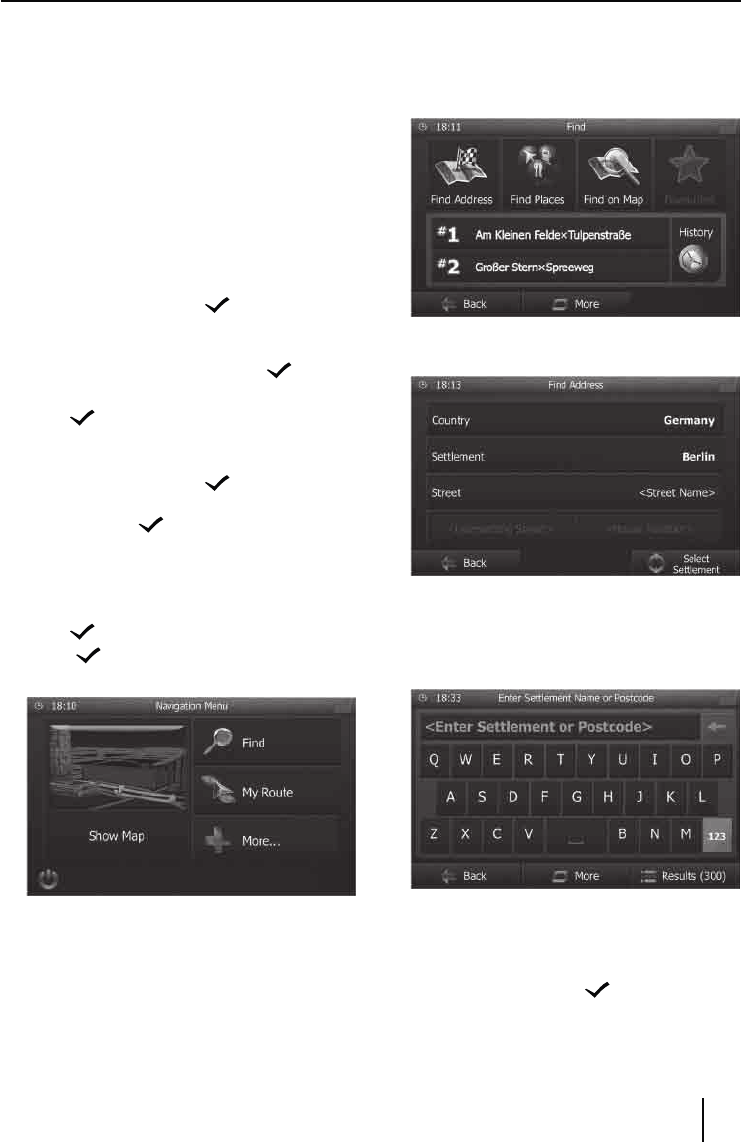
9
Starting the navigation
uIn the main menu, press Navigation to start the
navigation mode.
The navigation menu is displayed. If you start the
navigation for the rst time, the setup wizard is dis-
played.
Initial startup
If you start the navigation for the rst time, a setup wizard
appears which performs the basic settings for the naviga-
tion.
uAdjust the language for the navigation. This can be
a dierent language from the other functions of the
device.
uConrm the selection with .
The end-user license agreement is displayed.
uRead the end-user license agreement. If you agree
with the terms and conditions, press .
The conguration wizard starts.
uPress to continue.
uSelect a voice for the voice output of the navigation.
Various voices are available for the languages.
uConrm the selection with .
uSpecify the time format and the units for the naviga-
tion. Next, press .
On the next screen, you can perform your preferred
route settings.
uIf necessary, change the entries by pressing the dis-
played menu entries.
uPress , after you adjusted the settings.
uTouch , to nish the conguration.
The navigation menu is displayed.
Entering a destination
Destinations can be entered in dierent ways: Via the ad-
dress or as point of interest from the database of points
of interest. Points of interest can be sights, museums, sta-
diums, petrol stations.
Address
uOpen the navigation menu.
uPress on Find .
The menu for the destination entry is displayed.
uPress Find Address .
The menu for the address entry is displayed.
uEnter the country, city and street in succession as
well as the intersection or house number. To do so,
press the corresponding entry in the address entry
menu.
A menu for text entry is displayed.
uEnter the desired destination via the keyboard.
With every character entered, the entry in the input
line is automatically completed.
uIf the name of the desired destination is displayed in
the address line, press the button.
Navigation
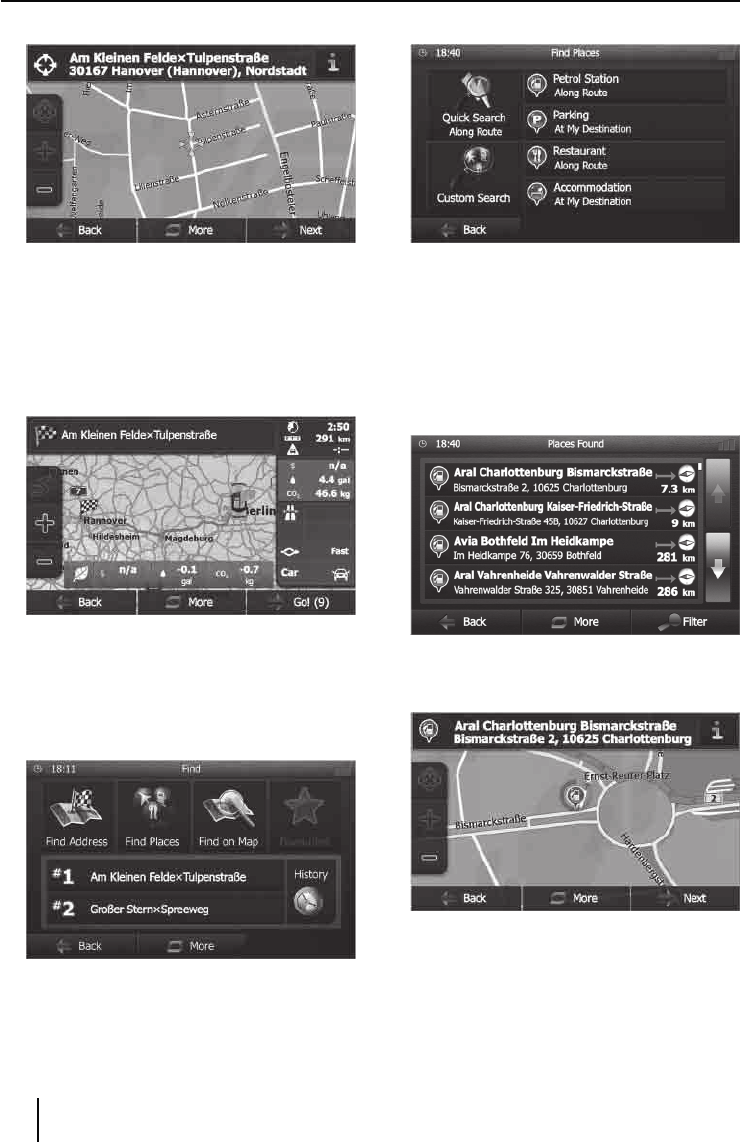
10
The selected destination is displayed on the map.
uPress Next to start the route guidance.
The calculation of the route starts. Depending on the
distance between start and destination, the route
calculation may take some time.
After the route calculation is complete, the param-
eters of the route, such as distance and time, are
displayed. In addition, the entire route is displayed
on the map.
uPress Go! to start the route guidance.
Points of Interest
uOpen the navigation menu.
uPress on Find .
The menu for the destination entry is displayed.
uPress Find Places .
The point of interest menu is displayed.
uYou can select a point of interest from one of the
four predened categories Petrol Station, Parking,
Restaurant and Accommodation or start a separate
search.
uFor example, press on Petrol Station to quickly
nd a petrol stations.
A list of petrol stations in the vicinity of the vehicle is
displayed. The petrol stations are sorted by distance
to vehicle.
uSelect a petrol station from the list by pressing on the
list entry.
The petrol stations is displayed on the map.
uPress Next .
The route course and the route data are displayed.
uPress Go! to start the route guidance.
Navigation
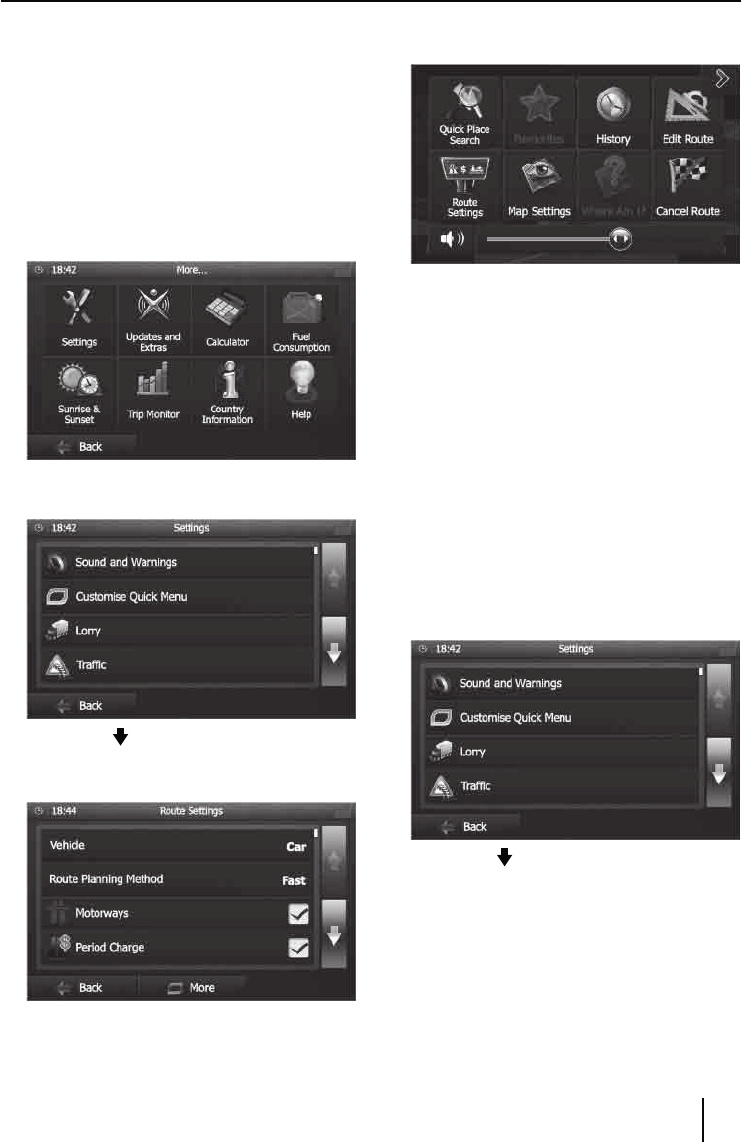
11
Setting route options
In the route options, the vehicle type, type of route
(quick, short, dynamic) and additional parameters are
dened which are required by the device to calculate the
route according to your requirements.
You dene the route options during the initial congura-
tion of the navigation, but you can change them for any
route guidance.
Adjusting route options before the route guidance
uCall up the navigation menu.
uPress More… .
uPress Settings .
The settings menu for the navigation is displayed.
uPress on the button to display the second page.
uPress Route Settings .
The route settings are displayed.
uChange the settings, if necessary.
uPress Back repeatedly until the navigation menu
is displayed again.
Changing route options during route guidance
uDuring a route guidance, press the More button.
uPress Route Settings .
The route settings are displayed.
uChange the settings, if necessary.
uPress Back .
The route guidance is displayed again.
Map Settings
With the map settings, you can adjust the view mode
(2D or 3D), the viewing angle of the map, the colours and
the display of buildings and points of orientation on the
map. In addition, you can specify for categories of points
of interest whether they should be displayed on the map,
e.g. car dealerships, cafés, restaurants.
uCall up the navigation menu.
uPress More… .
uPress Settings .
The settings menu for the navigation is displayed.
uPress on the button to display the second page.
uPress Map Settings .
Navigation
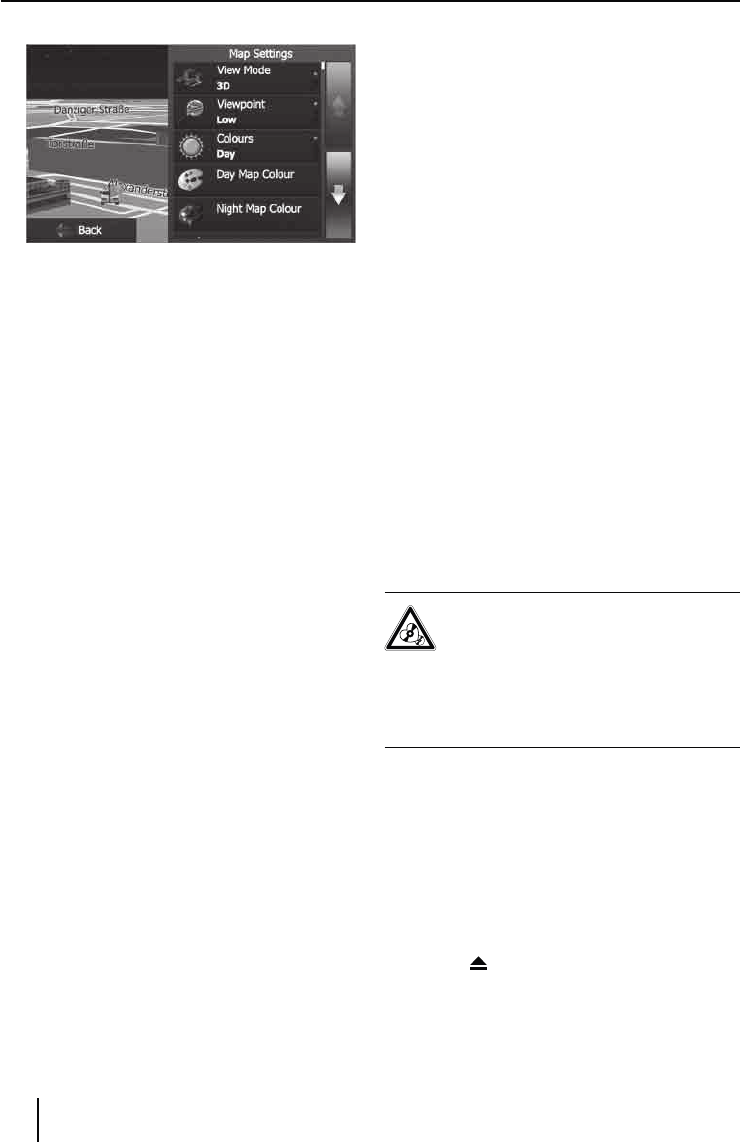
12
Navigation | DVD/CD/USB/microSDHC/iPod media playback
The map settings are displayed.
uChange the settings, if necessary.
uPress Back repeatedly until the navigation menu
is displayed again.
Note:
You can also change the map settings during the
route guidance:
uDuring a route guidance, press the More button.
uPress Map Settings .
The map settings are displayed.
uChange the settings, if necessary.
uPress Back .
The route guidance is displayed again.
DVD/CD/USB/microSDHC/iPod
media playback
Basic information
The car sound system can be used to play audio DVDs/
CDs (CDDA) and DVD/CD-R/RWs with audio or MP3 les
as well as MP3 or WMA les on USB data carriers and
microSDHC cards.
In addition, you can view movies and images from DVDs/
VCDs/CDs, USB data carriers and microSDHC cards on the
display or a connected monitor.
For safety reasons, the playback of movies and images on
the integrated monitor is allowed only while the vehicle
is standing and the hand brake is applied. The "BRAKE"
cable must be connected with the hand brake connec-
tion of the vehicle (see Connection diagram at the end
of these instructions). The movie playback on an external
monitor is also possible while driving.
Notes:
tTo ensure proper functioning, use only CDs with
the Compact-Disc logo and DVDs with the DVD
logo.
tBlaupunkt cannot guarantee the awless func-
tion of copy-protected DVDs/CDs and all DVD/CD
blanks, USB data carriers and microSD cards avail-
able on the market.
Note the following information when preparing an MP3/
WMA data carrier:
tNaming of tracks and directories: Max. 32 characters
without the le extension ".mp3" or ".wma" (the use
of more characters reduces the number of tracks and
folders that the car sound system can recognise)
tDVD/CD formats: DVD/CD-R/RW, Ø: 12 cm
tDVD/CD data formats: ISO 9669 Level 1 and 2, Joliet
tCD burn speed: Max. 16x (recommended)
tUSB format/le system: mass storage device / FAT/
FAT16/FAT32
tmicroSD card le system: FAT/FAT16/FAT32
tFile extension of audio les:
– .MP3 for MP3 les
– .WMA for WMA les
tWMA les only without Digital Rights Management
(DRM) and created with Windows Media® Player ver-
sion 8 or later
tMP3 ID3 tags: Version 1 and 2
tBit rate for creating audio les:
– MP3: 32 to 320 kbps
– WMA: 32 to 192 kbps
tMaximum number of les and directories:
– USB medium: Up to 10,000 entries
– microSD cards: Up to 10,000 les.
DVD/CD mode
Inserting a DVD/CD
Risk of severe damage to the DVD/CD drive!
Noncircular contoured DVDs/CDs and DVDs/
CDs with a diameter of 8 cm (mini DVDs/CDs)
must not be used.
We accept no responsibility for any damage to the
drive that may occur as a result of the use of unsuitable
DVDs/CDs.
uInsert the DVD/CD with its printed side up into the
DVD/CD tray
=
until you feel a slight resistance.
The drive automatically draws in the DVD/CD and
checks its data. Afterwards, the playback starts in
DVD/CD or MP3 mode.
Note:
You must not hinder or assist the drive as it automati-
cally draws in the DVD/CD.
Ejecting a DVD/CD
uPress the button
<
to eject an inserted DVD/CD.
Note:
You must not hinder or assist the drive as it ejects the
DVD/CD.
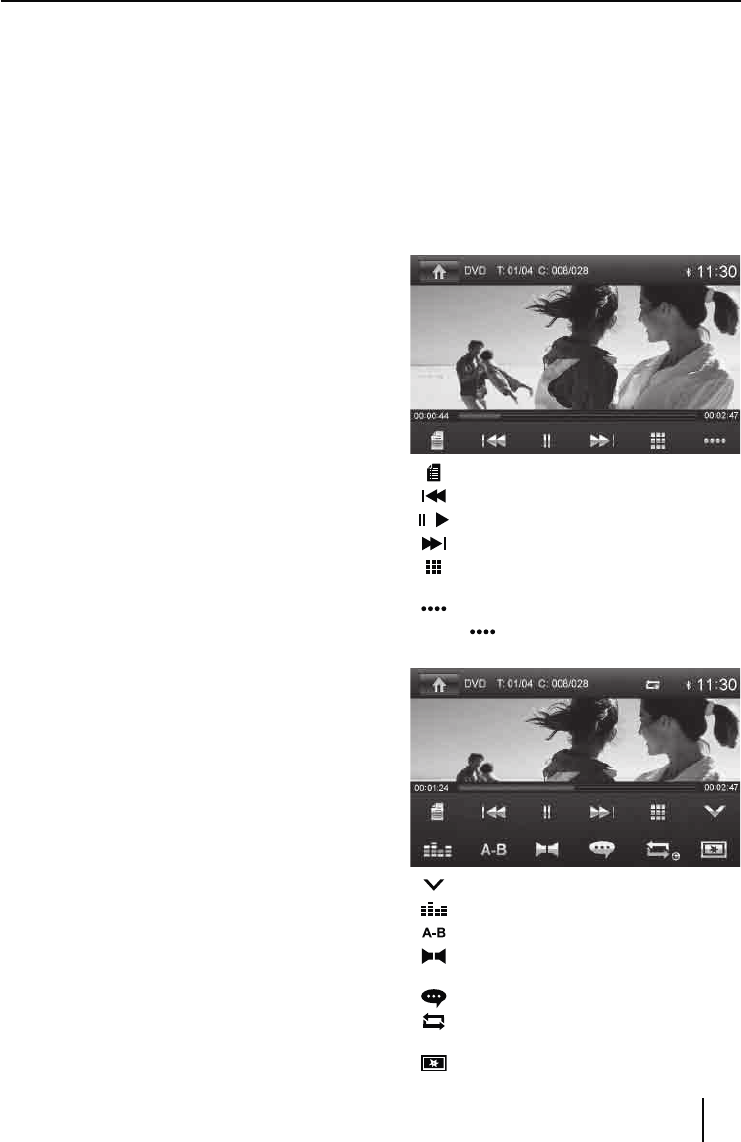
13
USB data carrier
This device features a USB port under the cover at the
front of the device.
Connecting a USB data carrier
uOpen the cover
6
underneath the rotary/pushbut-
ton.
uInsert the USB data carrier in the USB socket
:
.
The device automatically switches to USB mode. The
data are read, the playback starts with the rst media
le recognized by the device.
Removing the USB data carrier
uTurn o the car sound system.
uDisconnect the USB data carrier.
microSDHC cards
This device features an microSDHC card slot under the
cover at the front of the device.
Inserting the microSDHC card
uOpen the cover
6
underneath the rotary/pushbut-
ton.
uInsert the microSDHC card with its labelled side to
the left (attened corner to the top) and its contacts
rst into the card slot
8
until it clicks into place.
The device automatically switches to microSDHC
mode. The data are read, the playback starts with the
rst media le recognized by the device.
Removing the microSDHC card
uIf necessary, open the cover
6
.
uPush on the microSDHC card until it disengages.
uPull the microSDHC card out of the card slot
8
.
iPod/iPhone via USB
You can connect numerous iPod® and iPhone® models to
the car sound system via the USB port and control the
audio playback from the car sound system.
Note:
A list of compatible iPod® and iPhone® models is lo-
cated at the end of these instructions. Blaupunkt can-
not guarantee the awless function of other iPod®
and iPhone® models.
Use a suitable adapter cable to connect your iPod® or
iPhone® with the USB port of the car sound system.
uOpen the cover
6
underneath the rotary/pushbut-
ton.
uInsert the USB plug of the adapter cable into the USB
socket of the device.
The device automatically switches to USB mode. The
data are read, the playback starts with the rst media
le on the iPod®/iPhone® recognized by the device.
DVD movie playback
The car sound system can play video DVDs and VCDs. Af-
ter inserting the DVD, the playback starts automatically.
The DVD menu is displayed.
You can navigate in the DVD menu by touching the corre-
sponding buttons in the DVD menu on the touchscreen.
After starting the movie via the menu of the DVD, the
movie is displayed. The playback menu for DVDs is hidden.
uBriey touch the touchscreen once to display the
playback menu again.
The playback menu is shown.
[ ] Pause playback, call up DVD menu.
[ ] Select previous chapter.
[ / ] Interrupt playback and continue playback.
[ ] Select next chapter.
[ ] Call up keypad for direct selection of titles,
chapters or playing time.
[ ] Show additional operating options.
uTap on to display additional operating op-
tions of the playback menu.
[ ] Hide additional operating options.
[ ] Display equalizer.
[ ] Dene range for repeat function.
[ ] Select playback language (only if supported
by the DVD).
[ ]
Show subtitles (only if supported by the DVD).
[ ] Switch repeat function for title, chapter or
area A-B on/o.
[ ] Adjust image.
DVD/CD/USB/microSDHC/iPod media playback
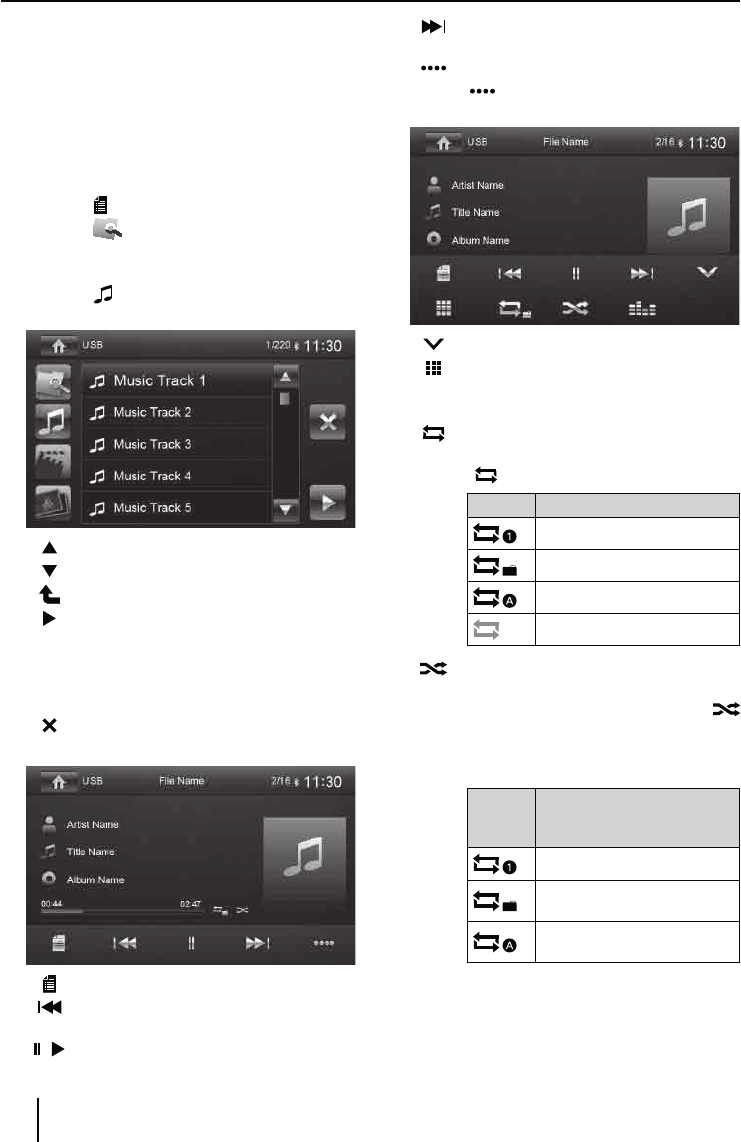
14
Audio playback from DVD/CD, USB,
microSDHC or iPod/iPhone
The principles of the audio playback (MP3/WMA) from
data carriers or iPod®/iPhone® are identical for all sources.
uSelect the desired source via the main menu.
The device changes to the desired source and the
playback starts.
If the playback does not start with the audio playback,
upress the button to change to the folder/file list.
uPress the button to display all the folders and
files of the data carrier (not in iPod®/iPhone® mode).
- Or -
uPress the button to display all the audio les of
the data carrier.
[ ] Scroll through the list page by page.
[ ] Scroll through the list page by page.
[ ] Change to next higher folder level.
[ ] Open selected folder or start titles.
- Or -
Briey tap twice (double-click) on the name
of the folder/track. The folder is opened/the
track is started.
[ ] Exit the folder/le list.
After starting a title, the playback menu is displayed.
[ ] Display the folder/le list.
[ ] Short press: Title selection.
Long press: Fast searching.
[ / ] Interrupt playback and continue playback.
[ ] Short press: Title selection.
Long press: Fast searching.
[ ] Show additional operating options.
uTap on to display additional operating op-
tions of the playback menu.
[ ] Hide additional operating options.
[ ] Display keypad to directly enter the number
of the desired title.
Audio playback from DVD/CD, USB or microSDHC:
[ ] Start and end REPEAT function.
The REPEAT mode changes each time the
button is pressed.
Display REPEAT mode
Repeat current track
Repeat current folder
Repeat all tracks of data carrier
Repeat title o
[ ] Start MIX random track play and end it
again.
If the MIX function is switched on, the
symbol is displayed in white.
The MIX mode depends on the selected
REPEAT function.
REPEAT
mode
display
MIX mode
No random track play
Mixing tracks of the current
folder
Mixing tracks of the data
carrier
DVD/CD/USB/microSDHC/iPod media playback
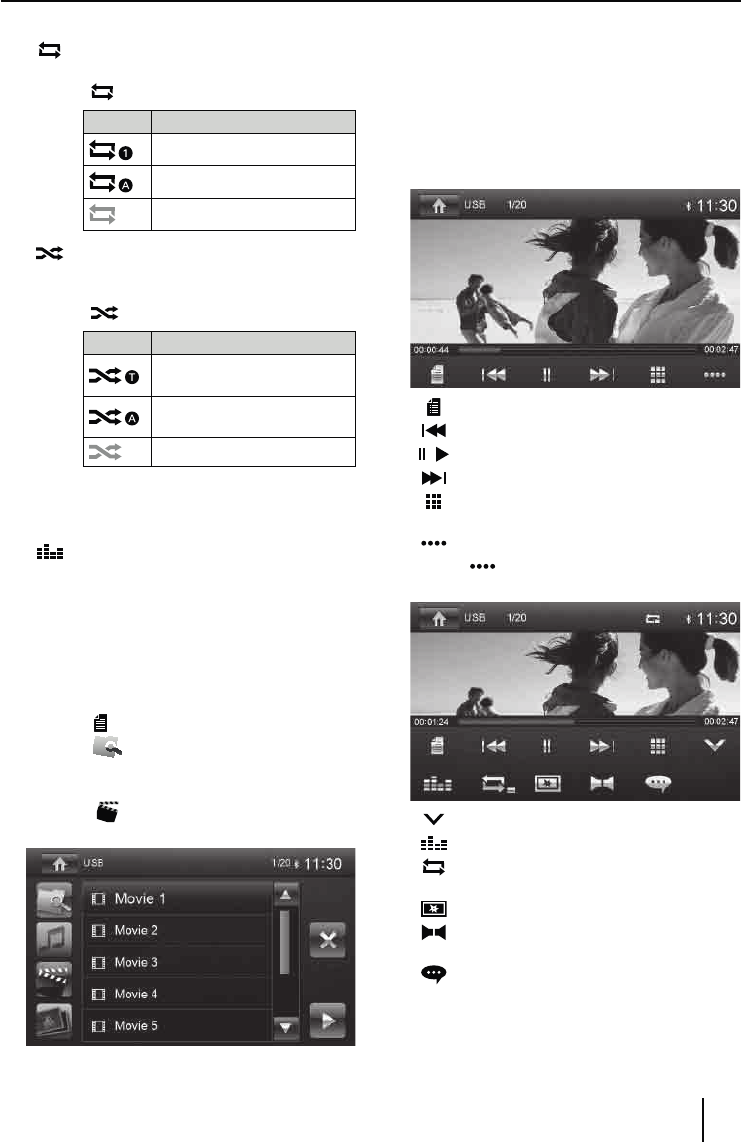
15
Audio playback from iPod®/iPhone®:
[ ] Start and end REPEAT function.
The REPEAT mode changes each time the
button is pressed.
Display REPEAT mode
Repeat current track
Repeat current selection
Repeat title o
[ ] Start MIX random track play and end it
again.
The MIX mode changes each time the
button is pressed.
Display MIX mode
Mixing tracks of the current
selection
Mixing tracks of the current
album
Random track playback o
Note:
The random track play of tracks depends on
the iPod®/iPhone® model used.
[ ] Display equalizer.
Video playback from DVD/CD, USB or
microSDHC
uSelect the desired source via the main menu.
The device changes to the desired source and the
playback starts.
If the playback does not start with the video playback,
upress the button to change to the folder/file list.
uPress the button to display all the folders and
files of the data carrier.
- Or -
uPress the button to display all the video les
of the data carrier.
Note:
Folders and videos are selected and started as de-
scribed under audio playback.
If you selected a movie, the playback is started. During
the movie playback, the playback menu is hidden.
uBriey touch the touchscreen once to display the
playback menu again.
The playback menu is shown.
[ ] Display the folder/le list.
[ ] Select previous movie.
[ / ] Interrupt playback and continue playback.
[ ] Select next movie.
[ ] Call up keypad for direct selection of movie
or playing time.
[ ] Show additional operating options.
uTap on to display additional operating op-
tions of the playback menu.
[ ] Hide additional operating options.
[ ] Display equalizer.
[ ] Switch repeat function for movie or folder
on/o.
[ ] Adjust image.
[ ] Select playback language (only if supported
by the movie).
[ ] Show subtitles (only if supported by the
movie).
DVD/CD/USB/microSDHC/iPod media playback
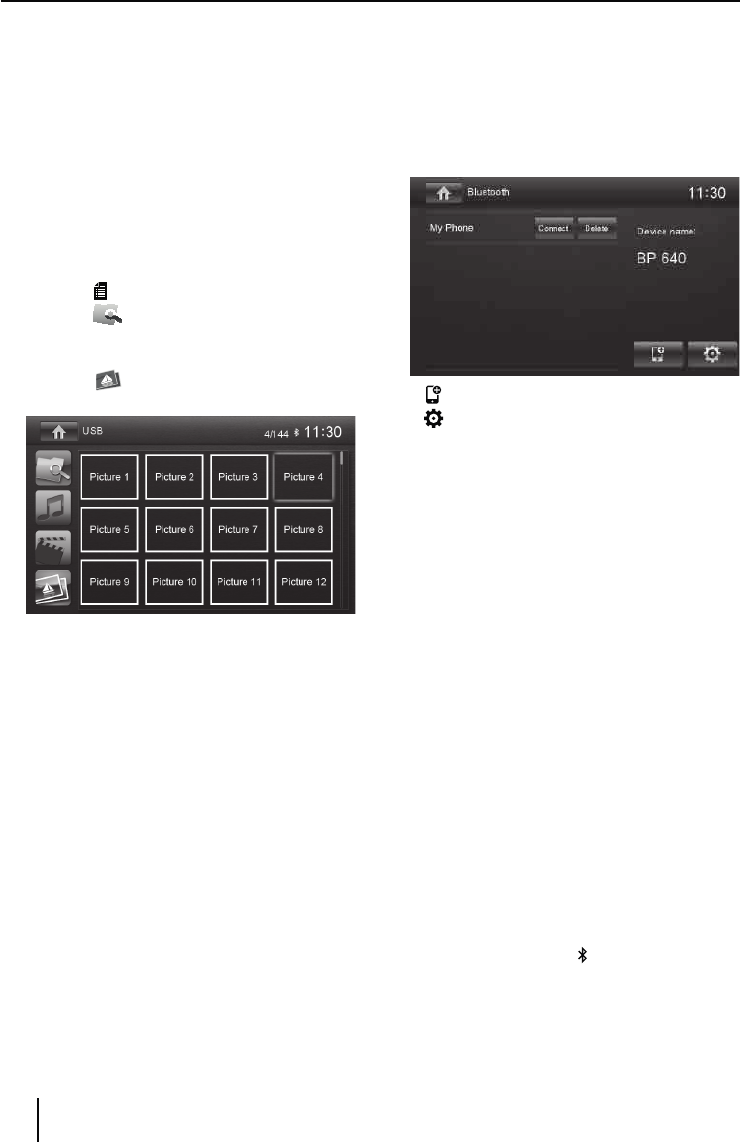
16
Note:
You can play back video les stored on an iPod®/
iPhone® with this device. For this purpose, the iPod®/
iPhone® must be connected with the device using a
special cable (USB - AV) that is commercially avail-
able.
Image playback from DVD/CD, USB or
audioSDHC
uSelect the desired source via the main menu.
The device changes to the desired source and the
playback starts.
If the playback does not start with the image playback,
upress the button to change to the folder/file list.
uPress the button to display all the folders and
files of the data carrier.
- Or -
uPress the button to display all the images of
the data carrier.
Note:
Folders and images are selected and started as de-
scribed under audio playback.
Bluetooth mode
The Bluetooth® function allows registering cell phones
and media playback devices with the car sound system.
When you register a cell phone with the car sound sys-
tem, you can make phone calls with the built-in hands-
free function. You can access the lists of dialled numbers
and the phone book of the registered cell phone.
If the connected Bluetooth® device supports the func-
tions A2DP and AVRCP, you can play the music via the
car sound system and control the playback. During a call,
the music playback is interrupted and continued again
after the call.
If a cell phone is registered via Bluetooth® and a call is re-
ceived during the playback of another source, the source
playback is interrupted and the call menu is displayed.
Starting Bluetooth mode
uIn the main menu, press on Bluetooth .
- Or -
uPress the MENU button
2
for approx. 2 seconds.
The Bluetooth® menu is displayed. It contains the list
of known Bluetooth® devices. Other audio sources
are switched o.
[ ] Add new Bluetooth® device.
[ ] Display options menu.
uPress the Connect button of the Bluetooth® de-
vice with which you want to establish a connection.
When the device is in range, the connection is estab-
lished and the menu for the device is displayed.
uPress the Delete button if you want to delete the
Bluetooth® device from the list.
Registering Bluetooth devices
If you want to register a device with the car sound system
for the rst time, proceed as follows:
uEnsure that Bluetooth® is activated at the car sound
system and at your Bluetooth® device.
uIn the options menu of the Bluetooth® mode, enter a
pairing code (see Bluetooth® settings).
uSearch for new devices/connections on your Blue-
tooth® device.
uThe car sound system appears as "BP 640" in the list
of Bluetooth® devices.
uEstablish the connection; you may have to enter the
pairing code that was previously entered on the car
sound system.
The connection is being established and the menu
for the registered device is displayed.
Note:
If a telephone is connected with the car sound sys-
tem, the Bluetooth® icon is displayed at the top
right edge of the display in all audio/video sources.
DVD/CD/USB/microSDHC/iPod media playback | Bluetooth mode
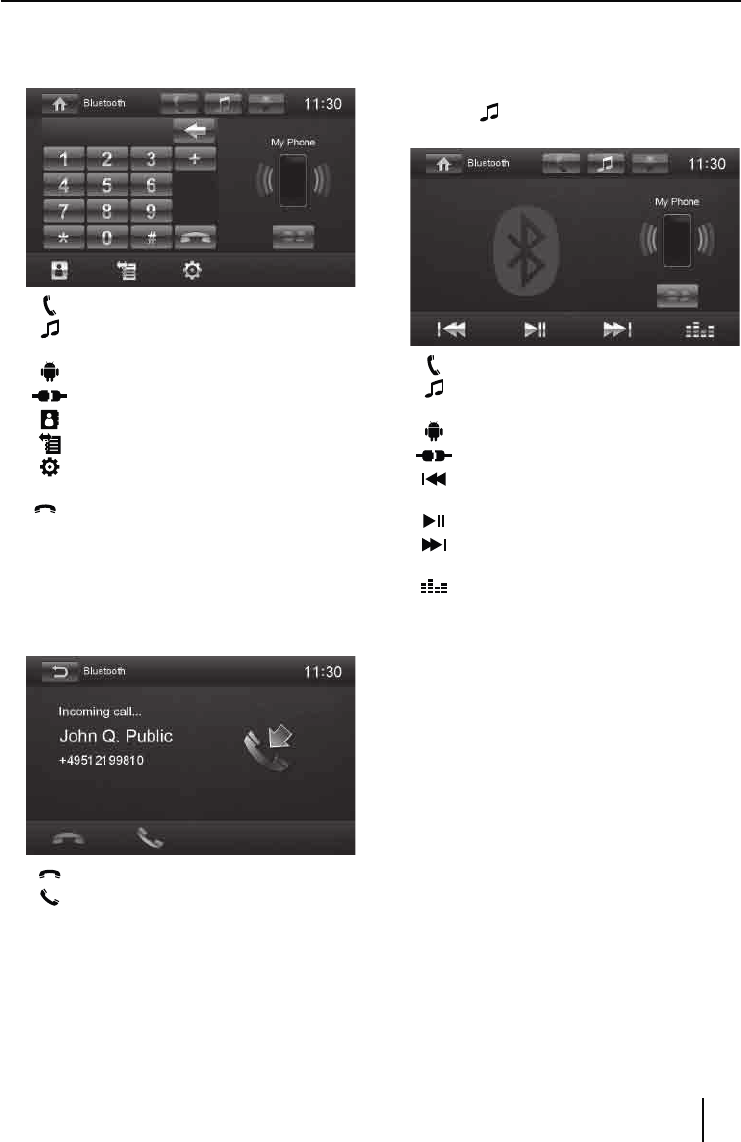
17
Telephone mode
If you connected a phone with the car sound system via
Bluetooth®, the following menu appears.
[ ] Display the phone menu.
[ ] Display the playback menu of Bluetooth®
streaming.
[ ] Display the playback menu
of app control
.
[ ] Disconnect connection with current device.
[ ] Call up the phone book.
[ ] Call up caller lists.
[ ] Display options menu.
uEnter a phone number with the keypad and press the
button.
- Or -
uSelect a contact/number via the caller lists or phone
book and press the Dial button in the pop-up
window.
The connection is being established.
If a call is coming in, the call menu is displayed.
[ ] Reject a call.
[ ] Answer a call.
Audio playback via Bluetooth streaming
If an audio streaming device is connected with the car
sound system via Bluetooth®, you can play back the mu-
sic via the car sound system and control the playback.
uPress the button to change to the audio play-
back.
[ ] Display the phone menu.
[ ] Display the playback menu of Bluetooth®
streaming.
[ ] Display the playback menu
of app control
.
[ ] Disconnect connection with current device.
[ ] Short press: Title selection.
Long press: Fast searching.
[ ] Interrupt playback and continue playback.
[ ] Short press: Title selection.
Long press: Fast searching.
[ ] Display equalizer.
Audio playback via app control
(Android cell phone)
With the "Blaupunkt Android Player Multimedia Series"
app, music les stored on an Android cell phone can be
divided into certain categories with the help of ID3 tag
information. This allows you to quickly and conveniently
select and play back music tracks across dierent catego-
ries. For this purpose, the app must be installed on the
Android cell phone. The "Blaupunkt Android Player Mul-
timedia Series" app can be downloaded on the Internet
from www.blaupunkt.com.
Note:
The audio playback via "Blaupunkt Android Player
Multimedia Series" app is available only for Android
cell phones with operating system Android 2.3 and
higher. In addition, the cell phone must support the
Bluetooth® proles SPP (Serial Port Prole) and A2DP
(Advanced Audio Distribution Prole).
Bluetooth mode
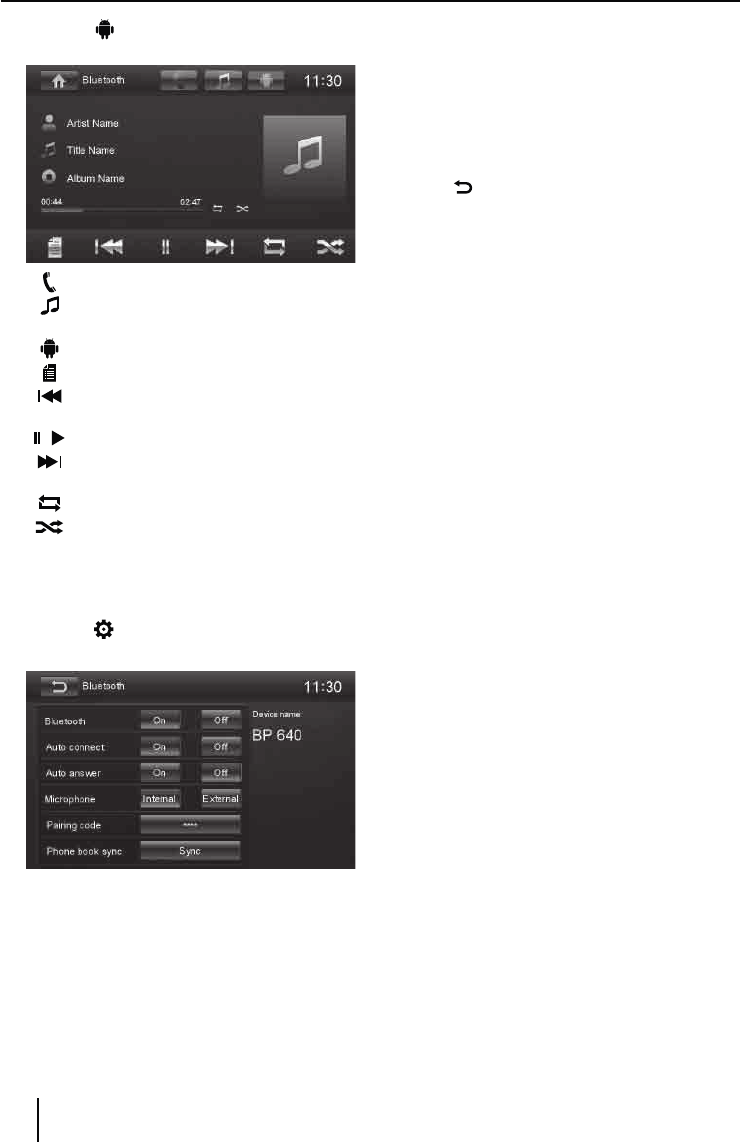
18
uPress the button to change to the audio play-
back.
[ ] Display the phone menu.
[ ] Display the playback menu of Bluetooth®
streaming.
[ ] Display the playback menu
of app control
.
[ ] Display category lists.
[ ] Short press: Title selection.
Long press: Fast searching.
[ / ] Interrupt playback and continue playback.
[ ] Short press: Title selection.
Long press: Fast searching.
[ ] Switch repeat function on/o.
[ ] Switch random playback on/o.
Bluetooth settings
In the options menu for Bluetooth®, you can make the
basic settings for the Bluetooth® mode.
uPress the button.
The options menu is displayed.
Bluetooth – Bluetooth® can be switched on or o.
Auto connect – If "Auto Connect" is activated, the
device automatically connects with known Blue-
tooth® devices as soon as they are in range.
Auto answer – If "Auto Answer" is activated, incom-
ing phone calls are automatically answered.
Bluetooth mode | Pandora® mode
Microphone – Select the microphone to be used for
the hands-free system via Bluetooth®.
Pairing code – Many Bluetooth® devices request the
pairing code before establishing the connection. You
can dene it here.
Phone book sync – To be able to access the phone
book of a connected telephone, you must rst syn-
chronise it via this menu entry.
uPress to exit the options menu.
Pandora® mode (available only in
the US, Australia and New Zealand)
Requirements
Control for Pandora® requires:
tAn iPhone device or an Android device with a reliable
data connection, or an iPod touch that is connected
to wireless internet.
tThe Pandora® app installed on the iPhone/iPod de-
vice or on the Android device.
tAn active account with Pandora®. Sign up at
www.pandora.com.
tThe USB sync cable that came with your iPhone/iPod
device.
tUsing an Android device it is necessary to establish a
connection to the car sound system via Bluetooth®.
Notes:
tPandora® is available only in the US, Australia and
New Zealand.
tRefer to www.pandora.com/everywhere/mobile
for devices compatible with the Pandora® mobile
application.
tPandora® is an internet service, carrier and data
charges may apply.
tSome Pandora® functionality cannot be operated
from this car sound system.
tFor issues using the Pandora® application, please
contact Pandora at pandora-support@pandora.com
tStations must be created in your account prior to
connecting your iPhone/iPod or Android device to
the car sound system.
Connecting the iPod/iPhone device
uOpen the cover
6
underneath the rotary/pushbut-
ton.
uConnect the iPhone/iPod device with the USB port
:
of the car sound system, using the USB sync cable
included with your iPhone/iPod device.
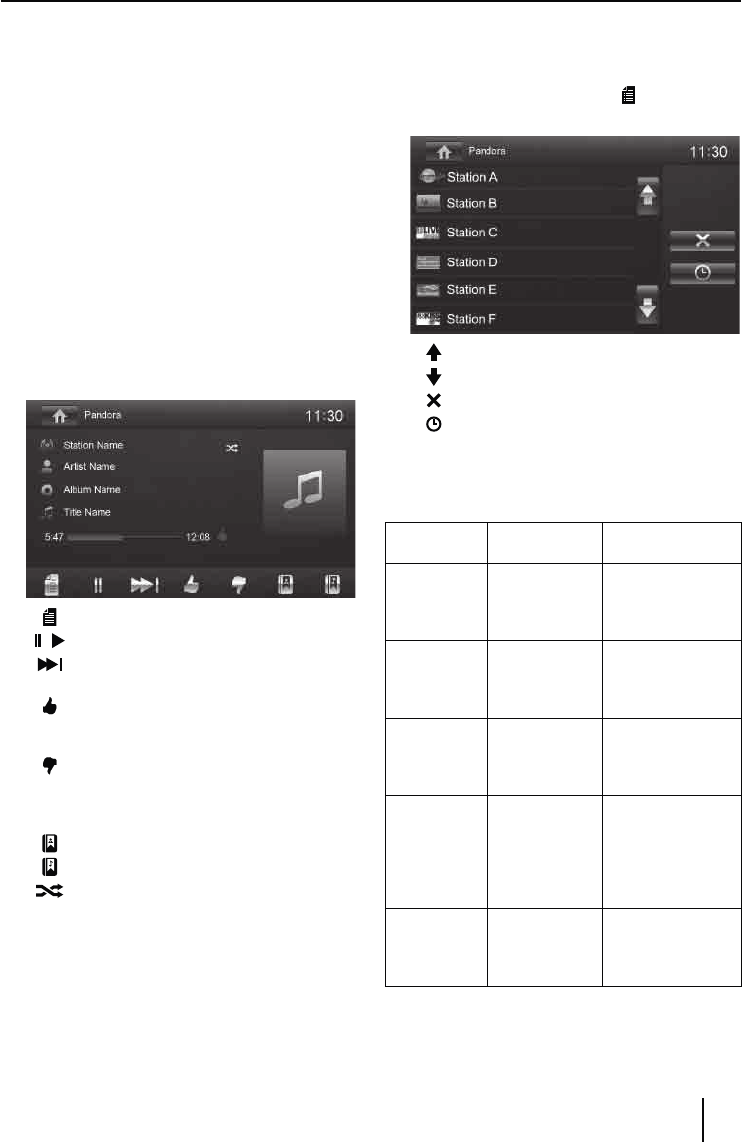
19
Pandora® mode
Connecting the Android device
uConnect the Android device to the car sound system
via Bluetooth®.
Starting the Pandora® mode
Note:
To use the Pandora® mode, rst set "Pandora" in the
general settings to "On". Then the Pandora source
can be selected in the main menu.
uLaunch the Pandora® application on your iPhone/
iPod or Android device.
uIn the main menu, press the [ Pandora ] button to
switch to the Pandora® mode.
Note:
If both an iPhone/iPod device and an Android device
are connected to the car sound system, a selection
screen appears to select one of the devices.
The playback menu is displayed.
[ ] Display station list.
[ / ] Interrupt playback and continue playback.
[ ] Skip to the next track, subject to the skip
limit.
[ ] Tell Pandora® you like the track currently
playing, and Pandora® will play more tracks
like it.
[ ] Tell Pandora® not to play this track. Pandora®
will skip to the next track. If the skip limit
has been reached, Pandora will continue to
play but your feedback will be recorded.
[ ] Bookmark an artist.
[ ] Bookmark a track.
[ ] Shue songs from all of your stations.
Station list menu
The station list menu allows you to search for music by
stations you created.
uIn the playback menu, press the button.
The station list menu is displayed.
[ ] Scroll through the list page by page.
[ ] Scroll through the list page by page.
[ ] Exit the station list menu.
[ ] List the stations by date.
Tap on the name of the station to choose that sta-
tion .
Pandora® Error Messages
Message
Displayed
Cause Corrective Action
BookMark
Track Error
Software Error The track could not
be bookmarked,
please try again in a
moment.
BookMark
Artist Error
Software Error The song could not
be bookmarked,
please try again in a
moment.
Thumbs Up
/ Down Error
"Error Track
Rating"
Software Error Song feedback
could not be sent,
please try again in a
moment.
No Active
Station Error
Software Error This account has no
stations in it. Please
visit Pandora.com
and login to your
account and add
stations.
Skip Limit
Reached
Software Error Please note that
Pandora® limits
skips to a maximum
of six skips per hour
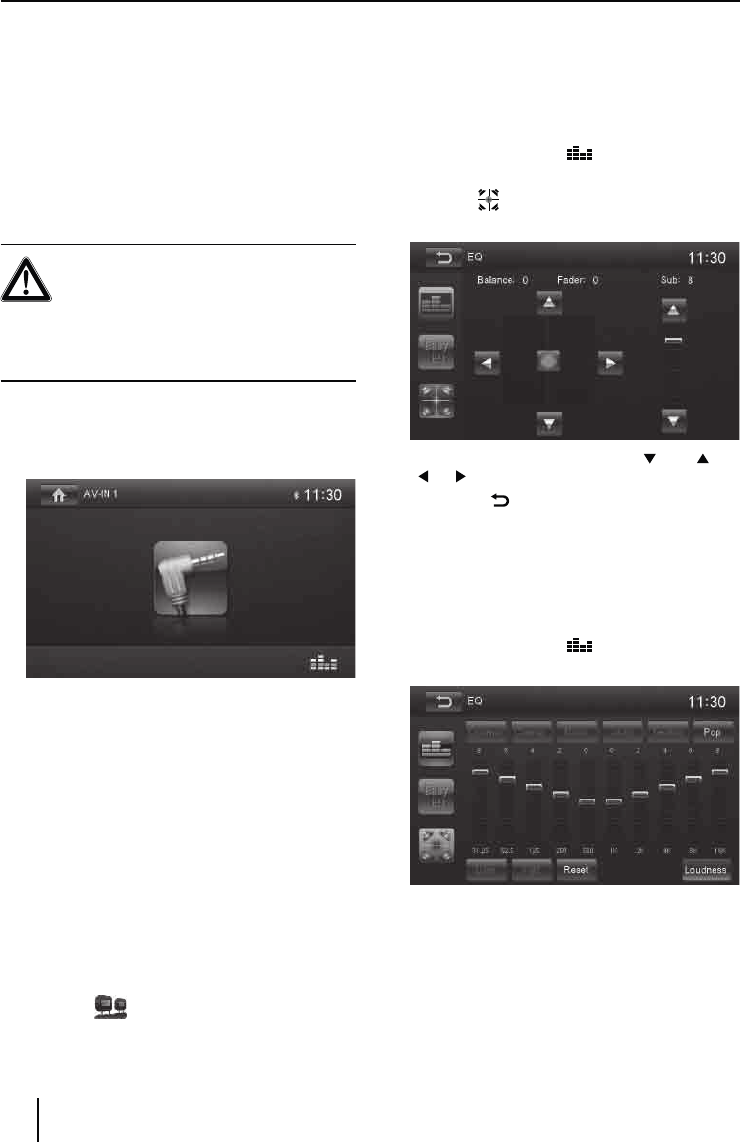
20
External audio/video sources | External monitor | Sound settings
External audio/video sources
AV inputs
This device features two external AV inputs for audio and
video playback:
tAV-IN 1 is located under the cover at the front of the
device.
tAV-IN 2 is implemented as a cinch socket on a cable
at the rear of the device. You can specify the instal-
lation location of the port during the installation of
the device.
Danger!
Increased risk of injury from connector.
In case of an accident, the protruding connec-
tor in the front AV-IN socket may cause injuries. The use
of straight plugs or adapters leads to an increased risk
of injury.
uStart the AV-IN mode with the button AV-IN 1 or
AV-IN 2 .
The display shows the audio or video playback of the
selected AV source.
Video input
This device features a video input at the rear of the device
for connecting a camera that is available as an option. If a
camera is connected, you can display the camera image.
uIn the main menu, press the Camera button.
External monitor
This device features an output for connecting an external
monitor for the rear area of the vehicle (see Connection
diagram at the end of these instructions).
uSelect the desired source via the main menu and
start the lm playback, e.g. from a DVD.
The lm is displayed on the monitor of the device.
uCall up the main menu.
uPress the button.
The lm is also displayed on the external monitor.
Sound settings
Volume distribution (fader/balance)
You can adjust the volume distribution in the vehicle
for all sources.
uIn the main menu or on the control bar of the current
audio source, press the button.
The equalizer menu is displayed.
uPress the button.
The menu for fader and balance is displayed.
uAdjust fader and balance with / or
/ .
uNext, press .
The setting is stored, the current source is displayed
again.
Equalizer
You can adjust the equalizer for all sources.
uIn the main menu or on the control bar of the current
audio source, press the button.
The equalizer menu is displayed.
uSelect a preset equalizer via the buttons.
- Or -
uPress the User button to adjust the level of the
available frequency bands according to your prefer-
ences.
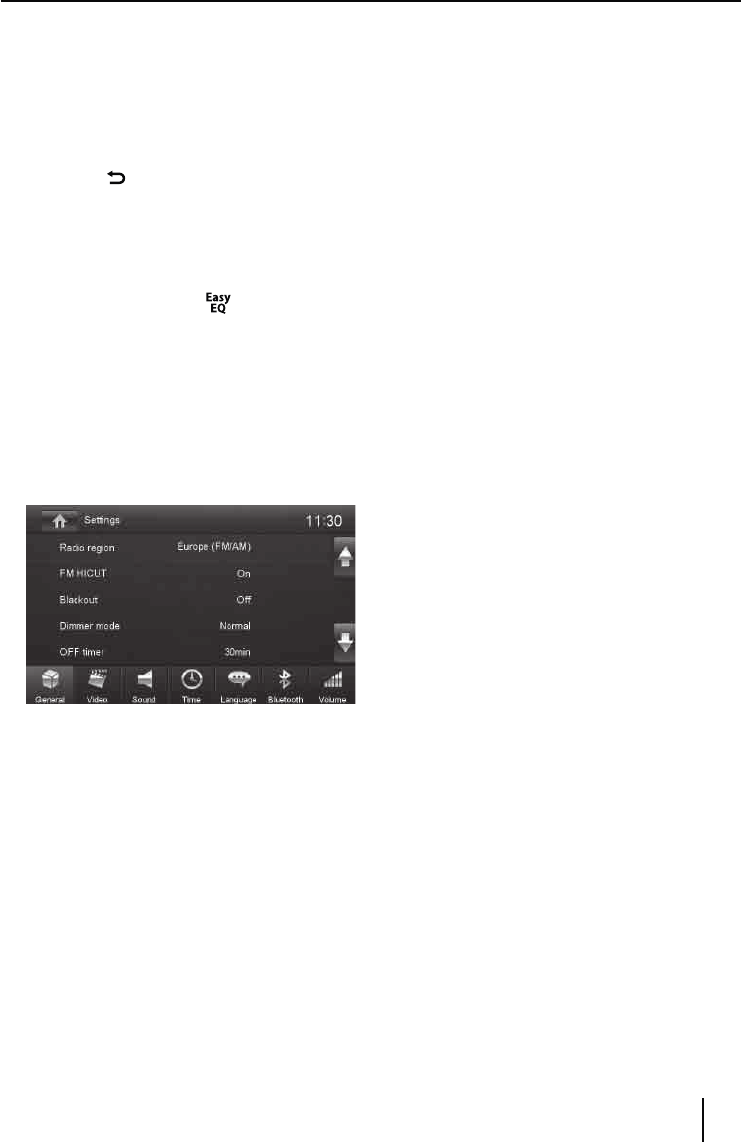
21
Note:
With the [ Reset ] button, you can reset the custom-
ised setting again.
- Or -
uPress the Flat button for a linear sound playback.
uPress the Loudness button to switch increasing
the bass at low volume on or o.
uNext, press .
The setting is stored, the current source is displayed
again.
Note:
In addition, you have the option to adjust the equal-
izer by using only three frequency bands. In the
equalizer menu, press the button and make
the setting as described before.
Basic settings
In the settings menu, you can adjust the basic settings
for the dierent functions of the device to your require-
ments.
uIn the main menu, press the [ Settings ] button.
The settings menu is displayed, the General sub-
menu is activated.
uCall up the submenus with the buttons in the lower
area of the settings menu.
General
The following settings are possible:
Radio region – Select the reception region for the radio
reception.
FM HICUT – Switches the Hicut lter for improving play-
back on/o.
Blackout – If this value is set, the display of the radio is
completely switched o after 10 or 20 sec. without use.
Dimmer mode – Adjust the display brightness
OFF timer – Setting the switch-o time. To protect the
vehicle battery, the device is automatically switched o
after the set time period if the vehicle ignition is switched
o.
Beep – Switch conrmation beep on/o
TFT calibration – The touchscreen can be calibrated
here.
SWC – The buttons of a connected steering wheel con-
trol can be congured here.
Rear AV-IN mode – If you connect a back-up camera
with audio signal to the AV-input at the rear of the de-
vice, you can play the camera tone via the loudspeakers
of the car sound system. To do so, enable "Camera mode".
Pandora – Pandora® can be switched on or o here
(Pandora® is available only in the US, Australia and New
Zealand).
Software version – Display of the current software ver-
sion.
Load factory settings – Resets all personalised settings.
Video
The following settings are possible:
Set password – Dene a password if you want to use the
parental controls.
Rating level – The rating of DVDs can be dened here.
If set to "Adult", all movies can be played back. If a pass-
word was congured, the rating level can be changed
only with the password
Sound
The following settings are possible:
Subwoofer – Switch subwoofer on/o
Subwoofer lter – Make the setting according to the
subwoofer used (settings: 80/120/160 Hz).
Dynamic sound – Switch dynamic bass on/o
Time
The following settings are possible:
Date – Set the date
Clock mode – Selection between 12 and 24-h mode
Time – Set the time
Auto clock – Switch automatic clock setting on or o
with the time data transmitted via RDS.
Language
The following settings are possible:
OSD – Language for the user interface of the device.
DVD audio – The audio playback of DVDs is started in the
language dened here.
DVD subtitle – The subtitles of DVDs are shown in the
language dened here.
DVD menu – The DVD menu is displayed in the language
dened here.
Sound settings | Basic settings

22
Basic settings | Useful information
Bluetooth
The following settings are possible:
Bluetooth – Bluetooth® can be switched on or o.
Auto connect – If "Auto Connect" is activated, the device
automatically connects with known Bluetooth® devices
as soon as they are in range.
Auto answer – Phone calls from connected telephones
are automatically answered if this option is enabled.
Pairing code – Many Bluetooth® devices request the
pairing code before establishing the connection. You can
dene it here.
Microphone – Select the microphone to be used for the
hands-free system via Bluetooth®.
Volume
You can adjust the volume ratio for all audio sources in
the volume menu.
Useful information
Warranty
We provide a manufacturer's warranty for products
bought within the European Union. For devices pur-
chased outside the European Union, the warranty terms
issued by our respective responsible domestic agency
are valid. The warranty terms can be called up from
www.blaupunkt.com.
Service
If you ever need to use a repair service, you will nd in-
formation about service partners in your country under
www.blaupunkt.com.
Subject to technical changes!
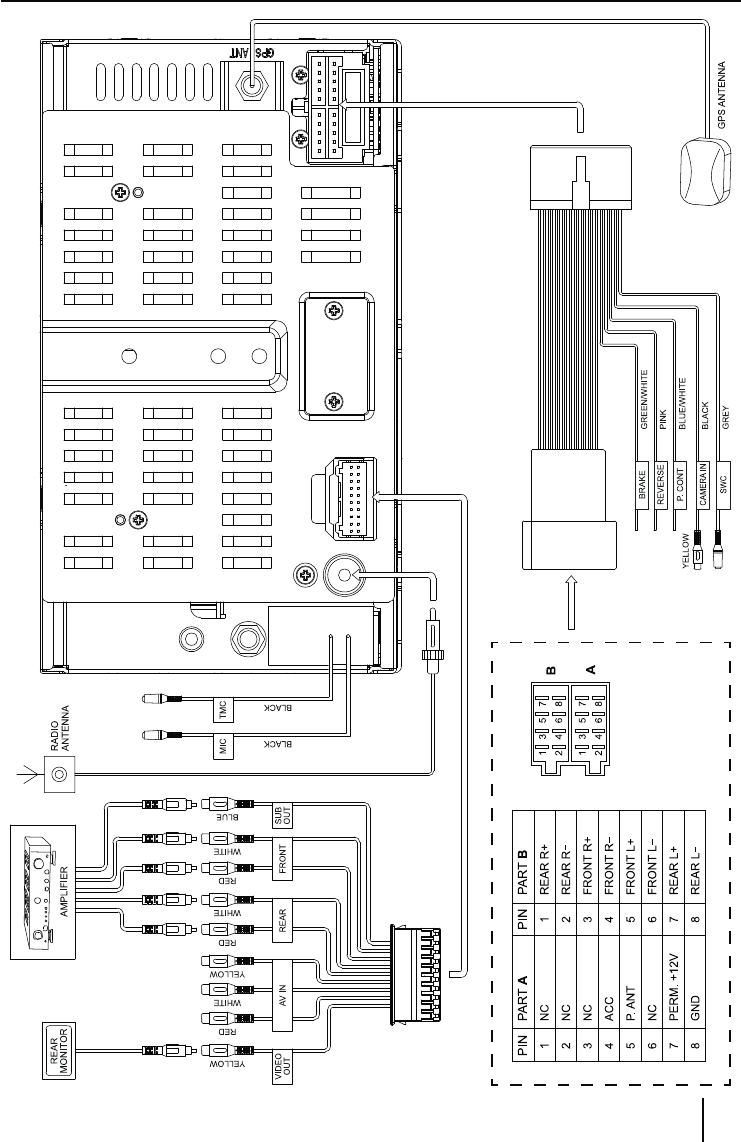
23
Connection diagram
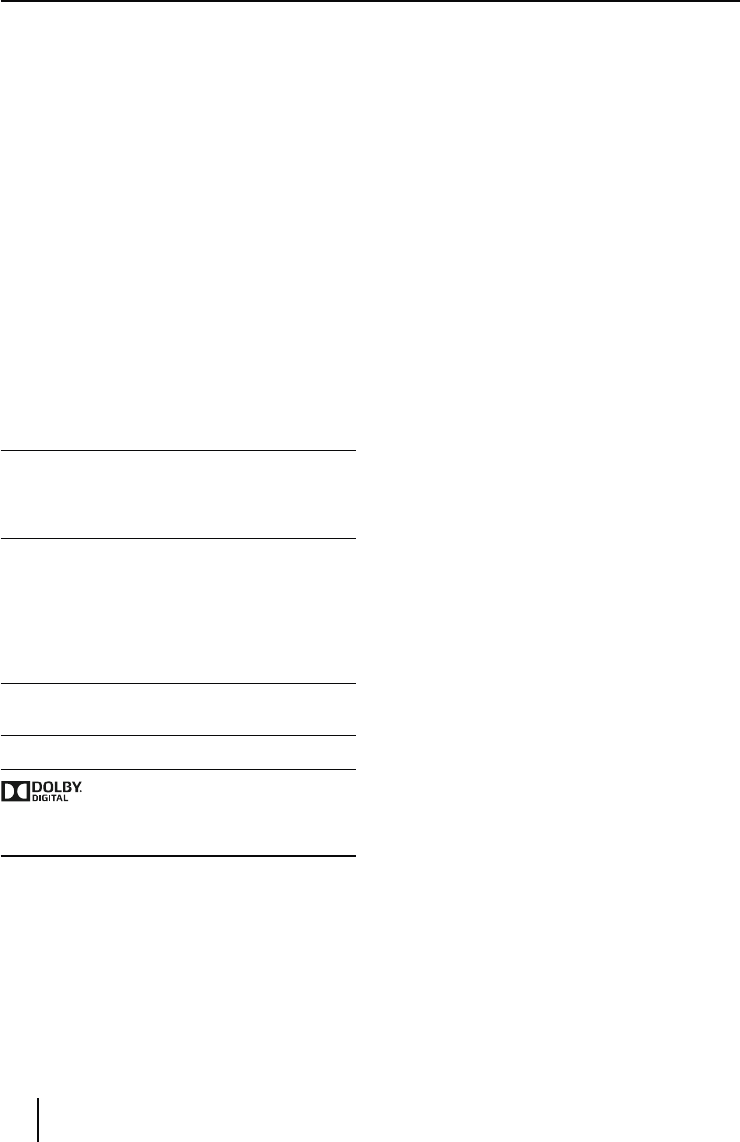
24
Supported iPod/iPhone devices
Our product can support below listed iPod/iPhone gen-
erations:
tiPhone 6 Plus
tiPhone 6
tiPhone 5s
tiPhone 5c
tiPhone 5
tiPhone 4s
tiPhone 4
tiPod touch (5th generation)
tiPod nano (7th generation)
"Made for iPod" and "Made for iPhone" mean that an elec-
tronic accessory has been designed to connect speci-
cally to iPod, iPhone respectively, and has been certied
by the developer to meet Apple performance standards.
Apple is not responsible for the operation of this device
or its compliance with safety and regulatory standards.
Please note that the use of this accessory with iPod,
iPhone may aect wireless performance.
iPhone, iPod are trademarks of Apple Inc., registered in
the U.S. and other countries.
This item incorporates copy protection technology that
is protected by U.S. patents and other intellectual prop-
erty rights of Rovi Corporation. Reverse engineering and
disassembly are prohibited.
Windows® und Windows Media® are registered trade-
marks of the Microsoft Corporation in the U.S.A. and/or
other countries.
This product is protected by certain intellectual property
rights of Microsoft. Use or distribution of such technolo-
gy outside of this product is prohibited without a license
from Microsoft.
The Bluetooth® word mark and logos are registered
trademarks owned by Bluetooth SIG, Inc.
Android is a trademark of Google Inc.
Manufactured under license from Dolby
Laboratories.
"Dolby" and the double-D symbol are trademarks of
Dolby Laboratories.
FCC Statement
1. This device complies with Part 15 of the FCC Rules.
Operation is subject to the following two conditions:
(1) This device may not cause harmful interference.
(2) This device must accept any interference received, in-
cluding interference that may cause undesired operation.
2. Changes or modications not expressly approved
by the party responsible for compliance could void the
user's authority to operate the equipment.
NOTE: This equipment has been tested and found to
comply with the limits for a Class B digital device, pursu-
ant to Part15 of the FCC Rules. These limits are designed
to provide reasonable protection against harmful inter-
ference in a residential installation.
This equipment generates uses and can radiate radio
frequency energy and, if not installed and used in ac-
cordance with the instructions, may cause harmful inter-
ference to radio communications. However, there is no
guarantee that interference will not occur in a particular
installation. If this equipment does cause harmful inter-
ference to radio or television reception, which can be de-
termined by turning the equipment o and on, the user
is encouraged to try to correct the interference by one or
more of the following measures:
tReorient or relocate the receiving antenna.
tIncrease the separation between the equipment and
receiver.
tConnect the equipment into an outlet on a circuit dif-
ferent from that to which the receiver is connected.
tConsult the dealer or an experienced radio/TV techni-
cian for help.
FCC Radiation Exposure Statement
This equipment complies with FCC radiation exposure limits
set forth for an uncontrolled environment. This equipment
should be installed and operated with minimum distance of
20 centimeters between the radiator and your body.
© 2015 All rights reserved by Blaupunkt. This material may
be reproduced, copied or distributed for personal use only.
Appendix

Blaupunkt Technology GmbH
Robert-Bosch-Straße 200
D-31139 Hildesheim
http://www.blaupunkt.com
06/15